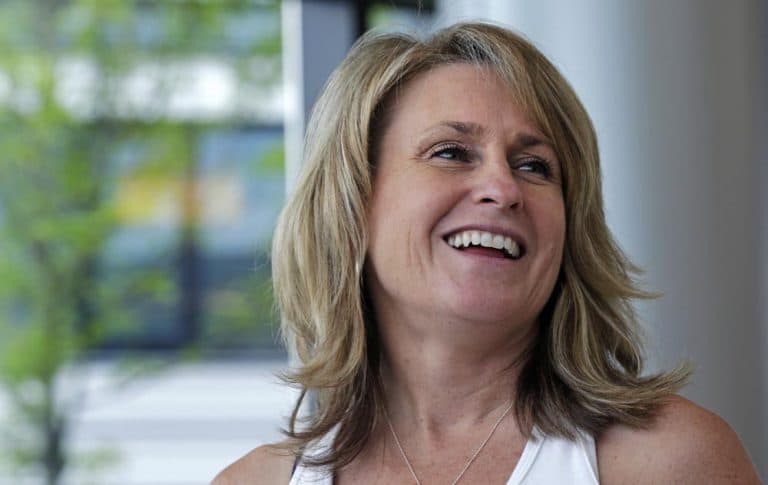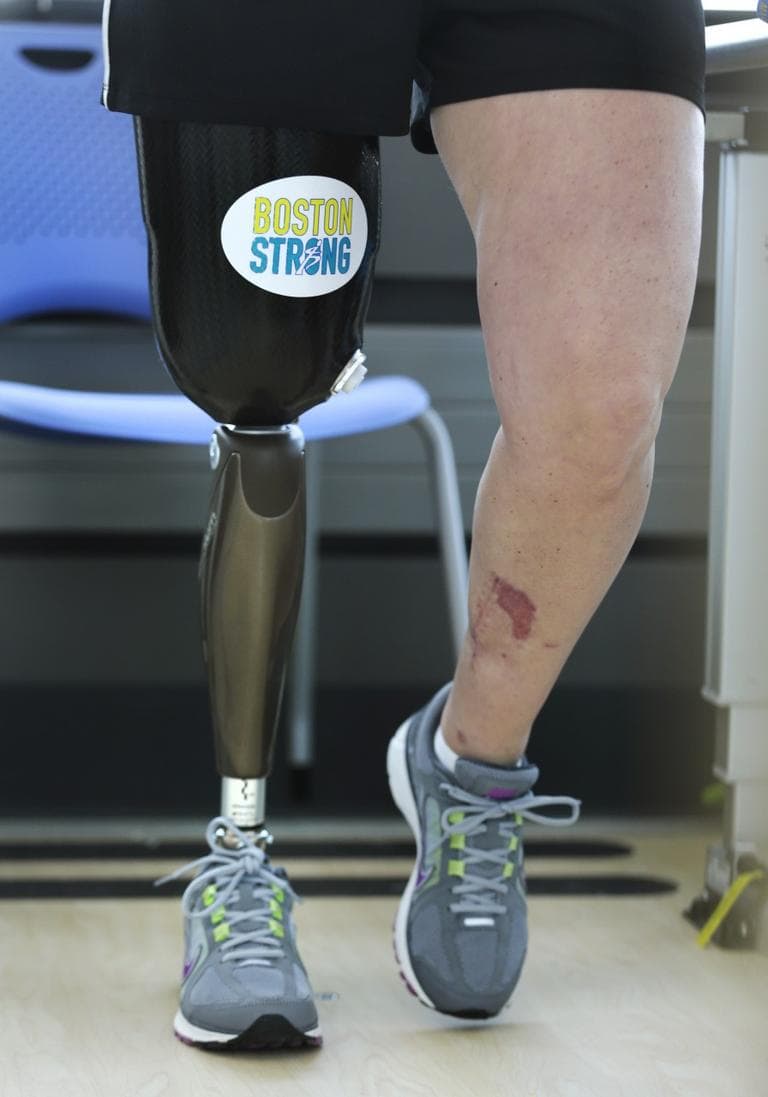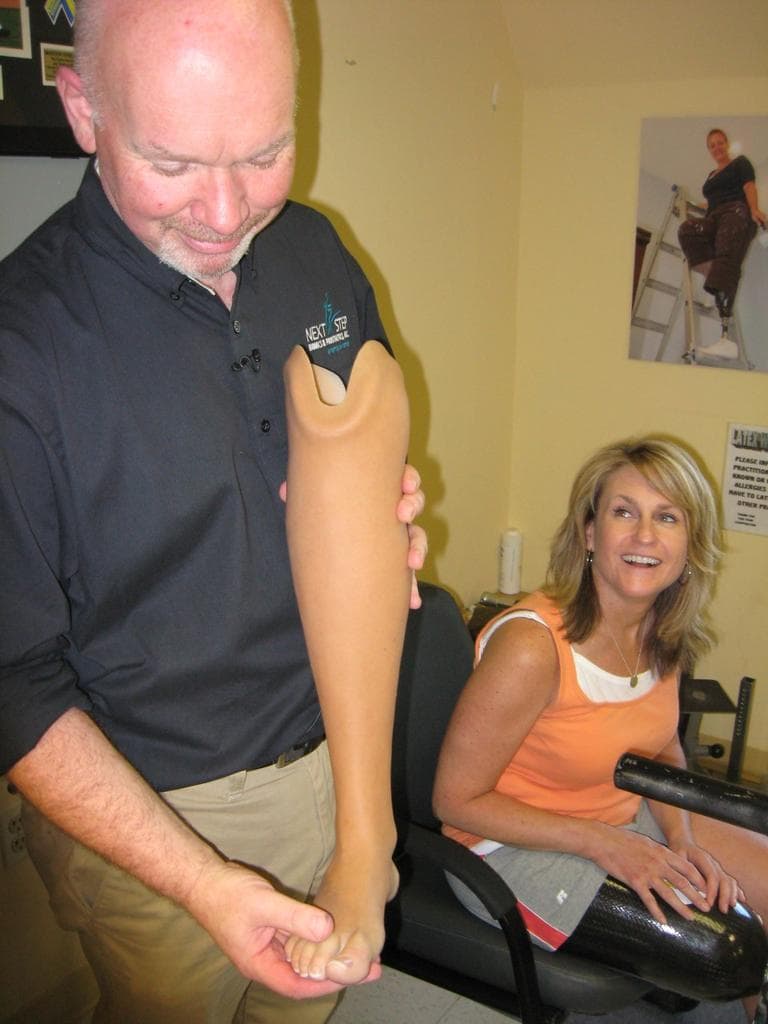Advertisement
Marathon Bombing Victim Makes Strides Toward Her New Normal

Roseann Sdoia sits in the lobby of Spaulding Rehabilitation Hospital, her $100,000 right leg stretched straight out from her right hip. The 45-year-old property manager from the North End holds the socket that covers her thigh in both hands, rocking it ever so slightly, back and forth. Sdoia's leg hurts. She had a hard time earlier sliding what remains of her thigh into the pinkish, carbon-fiber cup.
"It’s a little of a nuisance this morning," Sdoia says. "I had some chips last night and some olives and feta cheese."

Salty snacks? Is that why her leg is swollen? Some days, Sdoia, who stands 5-foot-1, has the opposite problem: her leg is too small for the socket.
She recalls looking down one day to see the artificial limb slowly "turning in."
"And I’m like, eventually my foot is going to be facing backwards if it keeps twisting like that," she says. "Every so often I would have to put a sock on to keep me suspended."
Sdoia carries around prosthetic socks to add or subtract layers, although she hopes she won’t need them as much with her new state-of-the-art prosthetic limb. The knee has a gyroscope for surface changes and six sensors that adjust for weight, direction and balance, as well as a microprocessor. Below the knee, rods of high-impact plastic end in an adjustable ankle and a carbon fiber foot. Once Sdoia gets her thigh into the socket, suction holds it tight so she won’t put any weight on the amputated end of her thigh.
"You want it to create suction, that’s how it stays on," Sdoia explains. "My limb is kind of suspended in the socket. It feels like when you put your ski boot on. I feel like my leg is in a ski boot of sorts."
Wiring malfunctioned in Sdoia’s first $100,000 leg and she had to send it back. She just got the replacement. So far her insurer, Blue Cross Blue Shield, is covering all the expenses. Eventually she hopes to have a running leg so she can get back to regular jogs, and a dress leg with a 2-inch heel foam molded to look like her natural calf and a silicon sleeve designed to match the freckles and even veins of her skin. Whatever the limb looks like, Sdoia is thrilled to have it.

"When I first put on the leg and looked down and saw two feet below me, it was an unbelievable feeling, even if it wasn’t my real foot."
Now Sdoia has to make the foot and leg work. Just going up and down the 18 stairs to her North End apartment takes a lot out of her. She’s fallen at home and is anxious to make sure that doesn’t happen when she returns to construction sites for her job as a property manager. The prospect of an icy winter is scary.
"I think if I fall in public it will be more dramatic because I think it will be more of an ego getting bruised than anything else." Sdoia says, laughing at this admission. But she's serious. "I don’t want anyone to look at me and say, 'Oh, that poor girl with one leg just fell.' "
At Spaulding’s gym, Arthur Graham, a certified prosthetist, uses a small Allen wrench to shorten Roseann’s leg just a touch.
"See what you think with the height and let me know," Graham says as he watches Sdoia take a few test steps. With two even legs, Sdoia is ready for physical therapy.
"There, see, that was a good knee bending," says physical therapist Urvashi Chogle, who moves with Sdoia down a row of step-sized green metal hurdles. But Sdoia is frustrated.
"I don’t know why it’s hanging like that for so long though," she says of her plastic calf. "Before it would straighten out" from the knee.
The two women are teaching Sdoia’s brain to send a new set of automatic stepping instructions to her thigh.
"The problem is with me, the way I’m swinging it, to get the knee to bend," Sdoia says. "I’m not using the right muscles."

Chogle jumps in: "It’s difficult to teach the leg what to do. [Sdoia] gets it right sometimes and sometimes she doesn’t."
Whisps of blonde hair fall out of Sdoia's ponytail as she pumps the pedals of a bike, tries to stand on a raised foam mat with her eyes closed and tosses a small, heavy ball while walking quickly.
"She needs to multitask when she’s walking. [I'm] just challenging her more, not like she doesn’t have enough challenges," Chogle says, laughing and glancing up at Sdoia's face.
"OK," Chogle finally says. "That’s it."
"Thank God. Take that thing," Sdoia says, tossing Chogle the ball.
On her way back to the front lobby, Sdoia stops four or five times to visit with other bombing patients and the therapists she’s become close friends with during her recovery. They catch up on wedding plans, boyfriends and one marathon amputee who is already wearing skinny jeans and walking without a limp.
The survivors and the people who are helping them navigate new lives see each other at Spaulding and at two or three tributes and fundraisers a week.
"I expect it’ll be like this through the anniversary and then it will probably die down," Sdoia says. "It’s healthy for me to keep talking about it and still work through it."
But tears come as Sdoia lets her mind go back to that day when she lost her leg.
"Sometimes it’s hard to think this is forever," she says. "But everybody says it gets easier and I’m sure it will. If we can fast forward to next year, that’d be great."
Sdoia heads home to get ready for two marathon survivor events. Part of her strategy is to stay busy, out in the world, as she gets used to life after April 15.
Listen to the audio version of this story below:
